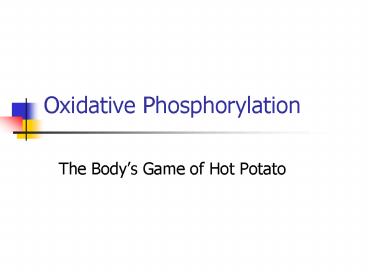Oxidative Phosphorylation - PowerPoint PPT Presentation
1 / 27
Title: Oxidative Phosphorylation
1
Oxidative Phosphorylation
- The Bodys Game of Hot Potato
2
AKA
- Electron Transport System
3
Location, Location, Location
- Location
- Inner mitochondrial membrane
4
The Meaning of It All
- Purpose
- How Many?
5
Break It Down!
- The ETS is a series of oxidation-reduction
reactions. - These reactions are facilitated by five enzymes.
- At the end of the ETS, O2 receives electrons (H)
and ATP is made.
6
Supply and Demand
- Where do the electrons come from?
- NADH/FADH2
- These reduced compounds carry the electrons from
the TCA to the ETS.
7
The Final Frontier
- The ETS is the final place for the breakdown of
macronutrients to make ATP. - TCA ? ETS ? ATP
8
Things to Remember
- Reduced Compounds
- Chemicals that have gained an electron.
- Electrons are represented by H in biochemistry.
- NADH FADH2
- Oxidized Compounds
- Chemicals that have lost an electron.
- NAD FAD
9
Things to Remember
- Reducing Agent
- The Electron/H donor.
- Oxidizing Agent
- The Electron/H acceptor.
- Redox Pair
- The conjugate forms of a molecule in reduced and
oxidized forms. - NAD ? NADH
10
The System
- Five Enzyme Complex
- The enzymes are called complexes.
- I through IV pass electrons to each other.
- V catalyzes the production of ATP, and is called
ATP Synthase.
11
Enzymes and Complexes
- NADH Dehydrogenase
- Transfers the H on NADH to complex I.
- Coenzyme Q
- Carries H from complexes I II to complex III.
- Cytochromes
- Porphyrin ring, containing Fe.
- Carry electrons down the transport system.
12
Im Open
- Who do we pass the electron to?
- This is determined by the
- Standard Reduction Potential.
13
Standard Reduction What?
- Standard Reduction Potential
- A measure of the tendency of a molecule to lose
electrons. - A more negative SRP A greater tendency to lose
electrons (oxidation). - A more positive SPR A greater tendency to gain
electrons (reduction).
14
Stop for Directions!
- Which way do the electrons move?
- From more negative SRPs to more positive SRPs.
- Remember, electrons are negative and move away
from negativity and toward positivity.
15
(No Transcript)
16
Building ATP
- Complexes I IV
- No ATP made.
- Proton gradient (Potential Energy) created.
17
Building ATP
- Complex V (ATP Synthase)
- Uses the Potential Energy from the proton
gradient to make ATP.
18
Get Out the Popcorn
19
(No Transcript)
20
Smugglers Blues
- NADH is also made outside of the mitochondria,
but it cannot get to the ETS because the inner
mitochondrial membrane is impermeable. - So, the NADH must sneak into the mitochondria via
the - Malate Aspartate Shuttle
21
(No Transcript)
22
Next Stop, The Matrix
- How does the Malate Aspartate Shuttle Work?
- The NADH on the outside gives its H to OAA
changing it to malate. The malate crosses the
inner membrane and releases the smuggled H to an
NAD in the matrix, forming NADH that can be used
in the ETS.
23
The Underground Railroad
- The Glycerophosphate Shuttle
- Works much like the Malate Aspartate Shuttle.
- The NADH on the outside gives its H to DHAP
changing it to Glycerol 3 - Phosphate. The
Glycerol 3 - Phosphate crosses the inner
membrane and releases the smuggled H to an FAD in
the matrix, forming FADH2 that can be used in the
ETS.
24
(No Transcript)
25
Regulation
- Stimulators
- ADP/AMP
- NADH
- FADH2
- O2
- Remember the Big Picture! Reactants stimulate
pathways.
26
Regulation
- Inhibitors
- ATP
- NAD
- FAD
- CO2
- Remember the Big Picture! Products inhibit
pathways.
27
One Last Look































